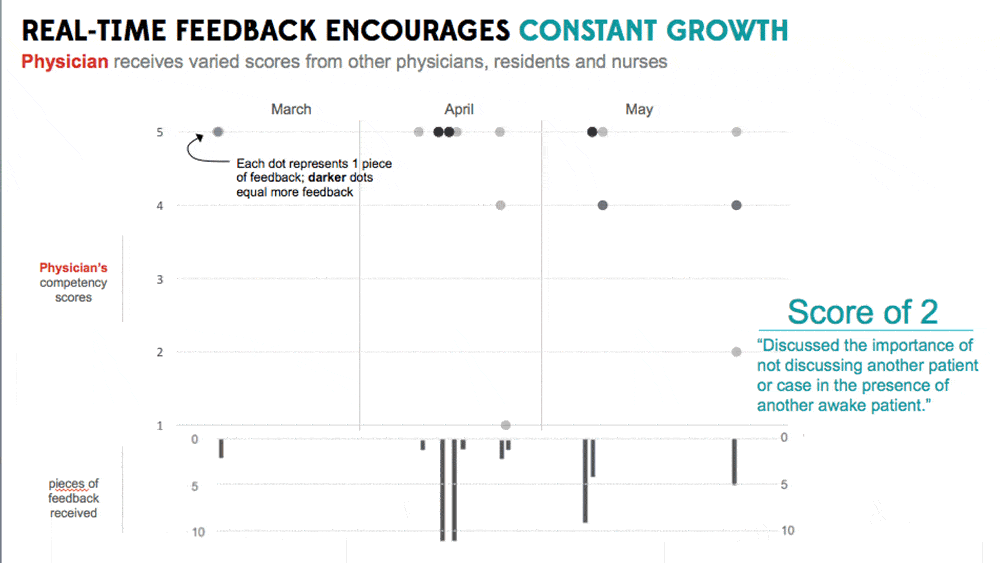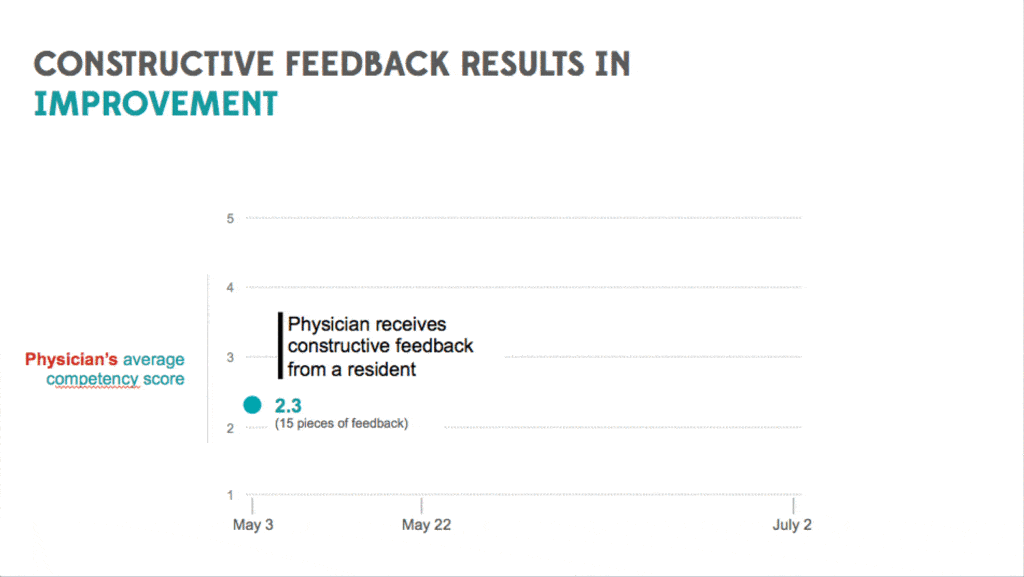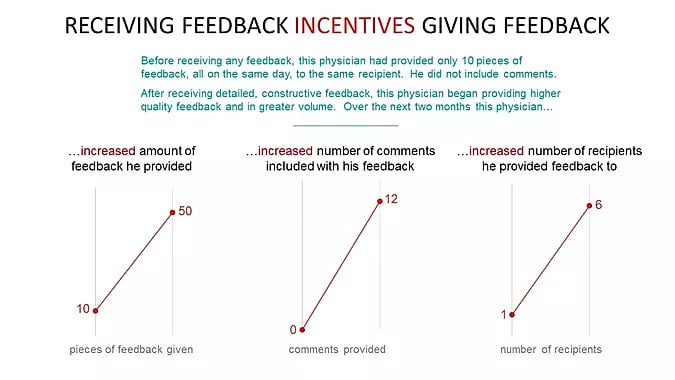In last week’s blog, DevelapMe explained how Temple University Health System (TUHS) flattened its hierarchical levels and promoted a culture of openness to maximize the flow of feedback. DevelapMe found strong evidence of significant performance improvement from TUHS employees resulting from real-time feedback. The three main insights gleaned from employees’ shifting to real-time feedback were:
- Real-time feedback encourages constant growth.
- Constructive feedback generates dramatic, sustained performance improvement.
- Receiving feedback incentivizes giving feedback.
1. Real-time feedback encourages constant growth.
Our team found evidence of real-time feedback allowing already excellent anesthesiologists to further excel through small behavioral tweaks. For example, a doctor who had received nearly exclusively high scores (4’s and 5’s on a 5-point scale) for several weeks received a constructive score of 2 for “Professionalism.” The comment read, “Discussed the importance of not discussing another patient or case in the presence of another awake patient.” The constructive feedback provided addresses a specific and infrequently occurring issue – exactly the sort of feedback that would be lost in an annual performance review.

A traditional annual review might spot major systemic problems, but would not catch a mishap of this type. However, even small lapses in professionalism can negatively impact a patient’s experience. Relatively minor tweaks across an entire company’s staff result in significant improvements in critical metrics such as patient satisfaction scores. An annual performance review would be unlikely to catch such lapses in judgement and would certainly not allow for immediate improvement. Real-time feedback enabled the doctor to immediately correct their behavior and improve, an adjustment that directly impacts patient satisfaction.
2. Constructive feedback generates dramatic, sustained performance improvement
In early May 2017, a TUHS doctor received 15 pieces of feedback from a resident direct report, 14 of which were constructive (i.e. a score of 3 or lower on a 5-point scale). The average feedback score was a 2.67. Crucially, ten of the pieces of feedback contained comments providing specific advice as to where the doctor could improve. For example:
“In a recent case, Dr. XYZ was less than encouraging in providing feedback during a technical procedure — i.e., speaking to every moment of my hand as I performed a line procedure and not allowing the learner to properly think, process and concentrate to execute the line. Having performed previous lines many times before, this was very distracting.”
Three weeks later, the same doctor received 13 additional pieces of feedback, albeit from a different resident. The doctor saw a massive feedback score increase, receiving a score of 5 on all 13 pieces of feedback. This remarkable improvement exemplifies the power of real-time, detailed, constructive feedback. The doctor knew exactly which developmental areas to focus on, and improved within weeks (as opposed to one year).
The doctor’s improvement can clearly be linked to DevelapMe feedback. The doctor earned perfect scores in the very areas they had previously received constructive criticism for, such as “Professionalism,” “Leadership,” and “Interpersonal and communication skills.” John Kotter’s seminal work, “Leading Change” discusses how short-term victories are essential for the success of any change effort. The constructive feedback galvanized the doctor to improve performance, and the improved scores increased the doctor’s “buy in” to the benefits of real-time, constructive feedback. TUHS employees were initially reluctant to give constructive feedback with comments. However, the data reveals that employees, instead of being hurt or reacting negatively, significantly improve performance.
Crucially, increased performance was sustained. The same doctor’s most recent piece of feedback received (at the time) was a score of 5 on July 2. In “Leading Change” Kotter also discusses how many change efforts fail because victory is declared after the first performance improvement. Consequently, the change effort is not institutionalized, and many of the gains are lost. It would be easy to declare success after noting the doctor’s rapid, dramatic improvement, and largely return to the status quo. DevelapMe avoids this pitfall because the app is a tool for continuous growth. Successes are commended, but employees are never “finished” improving.

Receiving exclusively scores of 5 is not necessarily ideal either. However, especially, in the early adoption stage of a new technology like DevelapMe, the improved scores show a clear trend of significant, sustained performance improvement. Over time, feedback scores should regress to “growth-level” feedback – a healthy mix of both positive and constructive scores, comments that are specific and detailed, and feedback exchange occurring regularly.
3. Receiving constructive, detailed feedback incentivizes giving feedback.
For the first several weeks of app implementation, one doctor received no feedback from fellow employees. During this time, the doctor had given only 10 pieces of feedback, all on the same day, to the same recipient. The doctor did not include any comments. After that same doctor received 15 pieces of constructive feedback, they immediately began providing higher quality feedback and in greater volume. The next day after receiving feedback, the doctor provided 16 pieces of feedback to three different recipients. Five comments were included. Since receiving the initial influx of feedback, over the following two months the doctor provided 51 pieces of feedback and 12 comments to 6 different recipients, with feedback continuing thereafter.
Usage data shows employees who receive a steady inflow of performance feedback are considerably more likely to provide insightful feedback at a high volume. As previously noted, receiving detailed, constructive feedback results in marked, sustained performance improvement. Therefore, promoting a free flow of honest information throughout all levels of the organization is essential for success.DevelapMe data shows how employees who receive feedback are more likely to provide it to others more frequently, with greater detail and specificity, to a larger number to recipients.

By analyzing DevelapMe data for insights, The Leadership Analytics Group showed TUHS how constructive feedback was incredibly beneficial for employee performance. Furthermore, receiving performance feedback generated “virtuous cycles,” where recipients provided detailed feedback with greater frequency to others. DevelapMe highlighted that employees were mistaking constructive feedback with criticism and noted how a cultural shift was necessary. By openly providing a mix of positive and constructive feedback with detailed comments, TUHS employees can fully harness the tremendous benefits of real-time performance feedback–and what’s more, their patients stand to benefit from it.
Additional resources:
Video: Watch Dr. Gordon Morewood discuss real-time feedback at TUHS:
